- Kriyacharya Jyoti went to Valley of Flowers. Dhari Devi appeared in her dreams. Ma Dhari asked her to visit the temple and discover why the murthy’s were shifted in June 2013 and current status.
It all started with a
profound feeling of restlessness, I had just completed and posted the kindle
version of my book online and the print version was on its way. As I sat idling
at home one afternoon, I was overcome by a sense of urgency to move out and get
away. This inner push saw me take off on a trek to the Valley of Flowers and
Hemkund on an impulse, deciding to leave in a matter of a few hours.
It was a long and arduous journey from Chandigarh. I was visiting the interior Himalayas for the first time after the floods of 2013. As we drove, I casually asked the driver about the temple that locals believe caused the whole disaster. I am not even sure what propelled me to ask the question, not much of a believer in superstition of any kind; I usually steer clear of religious overtures. But as we drove the driver pointed out the temple en route between Srinagar and Rudraprayag and we stopped to gaze at it from the road pretty much gawking like tourists.
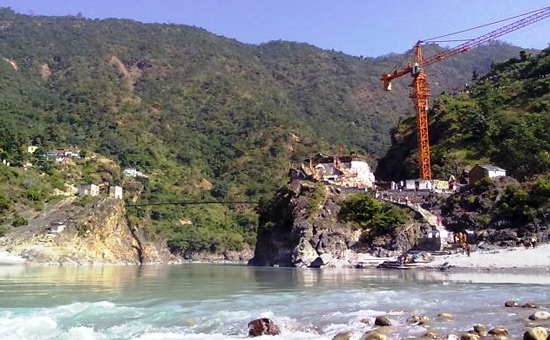 View before area was submerged. On top of boulder right of pic was Dhari Devi Mandir
View before area was submerged. On top of boulder right of pic was Dhari Devi Mandir
I once again
nonchalantly said we might stop over on the way back with no real intention of
doing so. We headed to Gobindghat, the starting point of our trek to Gangharia
and then onwards to Hemkund.
The next night, as I
slept in our cosy tent at Gangharia Ma Dhari appeared in a dream, at that
special time between sleep and wakefulness. It was just before I usually get up
for my daily morning meditation. The vision was clear and the message summoning
me to the temple and instructions for what she wanted me to do once there very
specific.
The next two days of
trek was torturous for me, I had come on a whim with no prior fitness regime to
prepare for it and it showed. This was my second trip to the Valley and Hemkund
after 23 years and I was not even sure why I had come. I walked, fluidly
cursing myself for this foolishness. But make it I did, both on day one and
two.
All along, throughout the
trek was an undercurrent of excitement about visiting the temple of Dhari Devi
on the return journey, an expectation that is difficult to explain.
A bit
about the temple
Sandhya Jain wrote, “Dhari Devi (Kali) is a unique form of Parvati and Ganga (earth and water). Her open air temple on the banks of the Alaknanda in Srinagar, Garhwal district, is one of the 108 Shakti Peeth mentioned in Devi Bhagavat. It houses the ‘upper torso’ of Devi. The body of Devi, in the form of a Sri Yantra, is housed at Kalimath temple in Rudraprayag district, in an exact NE-SW alignment, symbolizing Kali sleeping. The Kedarnath jyotirliñga is exactly north from Kalimath."
Dhari Devi is considered to the guardian deity of Uttarakhand and is revered as the protector of the Char Dhams. Pranams.
Darshan at the Temple
We left Gobindghat in
the early morning and reached Dhari Devi after noon. Walking down the ramp to
the temple I could not but wonder at why Ma had so surely summoned me. I was
not sure if the pujari would even
perform what I was so clearly instructed to do.
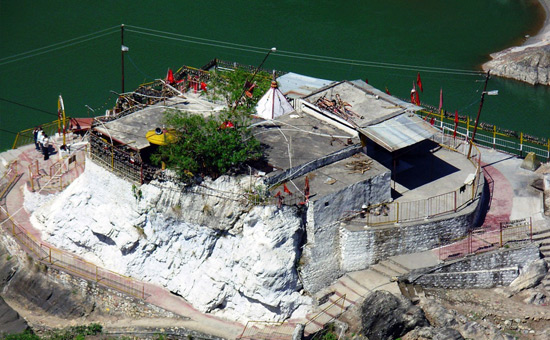 Original Temple, on a hillock, close up view.
Original Temple, on a hillock, close up view.
But my trepidation was
unwarranted for as soon as I told the main pujari Pt. Manish Dev Pandeyji, that
Ma had come in my dream and asked me to perform this specific offering; he took
it from me saying I was the second person to have come in the last few weeks
after a dream appearance of the Devi. He believed it was time and she now wants
the incidents leading to her forceful eviction be made more public and that she
is probably now ready to move back to her mool
sthan. Pt. Manish’s family have been the custodians of this temple for generations and are residents of village Dhari.
This Video shows stilts of a concrete structure built on the boulder on top of which is the structure that you see below. See video in conjunction with the above pic to know how high the water has risen.
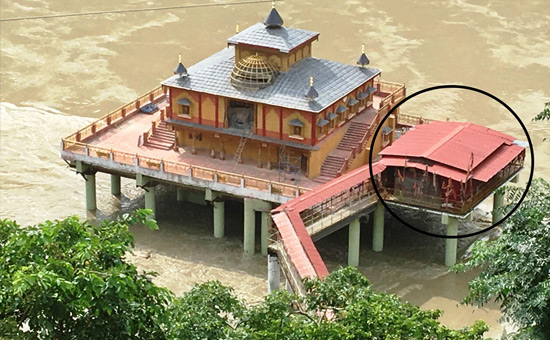 Makeshift structure, as exists today, marked on right of pic as a circle.
Makeshift structure, as exists today, marked on right of pic as a circle.
The idols, at present,
are in a makeshift shed to the side of a main structure. Behind the idol was
what looked like portion of a boulder, but was in actuality a fibreglass sheet
crumpled and made to look like a boulder. This boulder like appearance is
duplicated in the main structure too. From far it looks as if the temple is built
around a boulder but Panditji informed that it too was just cement and bajri made to look like a boulder.
It does not seem that the current structure has any contact with the base rock from which it was raised. The boulder highlighted in the pic below intends to create an illusion of such a contact though.
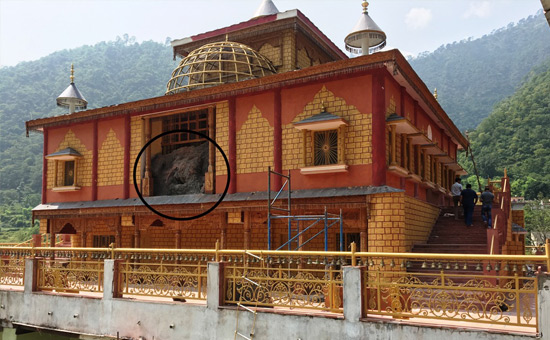 Pic of fake boulder marked as a circle.
Pic of fake boulder marked as a circle.
As we chatted, Ma gazed
serenely at us a witness to the whole conversation. Panditji went on to recount
the incidents leading to the ill-omened floods of 2013. The veil lifted
gradually from the various accounts that I had heard during our journey and
before about the shifting of Ma from her established sthaan.
Shifting
of Murthy
First a background. Anuradha Dutt wrote that the state government allowed Alaknanda Hydro Power Co Ltd – a GVK group company, to raise the height of the dam to 90 metres by relocating the shrine on a platform above the original site. Its power capacity was boosted to 330MW which entailed raising its height and drowning the shrine. She added “last July, senior BJP leaders had extracted an assurance from Prime Minister Manmohan Singh that the shrine would not be submerged. Mr Singh, true to character, later backtracked.” Source
DailyPioneer
Apparently, since the
conception of building the dam the contractors had been promising to first
raise part of the boulder embedded in the river Alakhnanda, on which rested the
original idols of Dhari Devi to a higher platform, so the Devi would not be
disturbed from her original place but would just be lifted up in the same
location on her existing platform.
The idea mooted was this would be done before the construction of the dam while the water level was still low. It was a big project and would involve using hydraulics to gently ease the boulder from the riverbed while securing it in place inch by inch. This would have added to the cost of construction of the dam development. The second suggestion was to cut a part of the boulder with a laser from under Ma’s sthaan and relocate it in the new temple above.
Work on the project
started in 2007 and core concrete work in 2009 and 2010. Throughout the
officials of the Company and local government officials were in constant
consultation with the temple management promising them that the idols will be
moved only after the promised end result ie raising of the boulder.
But promises made were
never kept, construction of the dam started and was completed while the temple
slowly started to flood. A temporary structure was constructed some 611 metres
above the river apparently to house the idols while work to bring up the
boulder was in progress. Then pressure started to be applied to shift the idols
to this space in a rush. The priests of the temple resisted even going on boats
to do daily prayers at the slowly sinking temple.
eSamskriti reached out to the GVK group who said, “We would like to clarify that during the consultations with all concerned in the temple management, it was suggested by them that part of the boulder should be raised to a higher platform and we assured them (never promised them) that we would certainly look into the feasibility.”
Finally, on the ill fated day of June 16, 2013 they were left with no choice but to remove their beloved Mother’s idols to save her from sinking completely under water and shift her into the makeshift temple. The idols were shifted in the evening and almost within some hours Uttarakhand saw one of the country’s worst disasters, natural or created by man is a debatable point.
For India TV video of how Dhari Devi murthy was removed that evening.
According to conservative estimates loss of life and properties were phenomenal. Today, six years later the number of people who died is yet to be established. Assessing damage is an impossible task and is beyond the scope of this article. Suffice to say it’s immeasurable.
The local belief that
shifting the Devi had brought this calamity on them takes roots from a similar
effort to move her in 1882 which resulted in a catastrophe akin to this. This
belief spread like wildfire around the country raising passions and emotions of
devotees.
Call basing the cloudburst
and subsequent floods on shifting the idols a superstition or label it
coincidence, but the fact remains that sentiments of the local population were
hurt with strong-arm tactics and not meeting promises made.
Aastha or faith has a great role in the simple minds of the people of this country and forms the foundation of the daily lives of many people.
In a country wracked by
corruption, unemployment and piteous living conditions, people find ways to
deal with their daily lives with this faith in a divine presence, call it by
any name. To run roughshod over such sentiments without any care ultimately
brings disaster in its slipstream.
Today there is pressure
to move the idols to the brand new structure with the fake boulder and move on.
Pandit Manish says the temple management is resisting this, though the hope for
the boulder to be raised as promised or portion of the boulder laser cut and
brought up seems to be a distant dream as cement has been poured and holes
drilled in the boulder below in order to bring up the existing structure. Yet
they hope for a real rock to place the idols on in the new temple.
GVK group said, “However, when we considered all the technical aspects, it was found that the boulder was fractured and trying to raise it using laser cutting, would only end up in the total disintegration of the boulder. Hence the boulder could not be raised.”
They also want the
narrow bridge leading to the temple widened. Their fear being the collapse of
the flimsy bridge on festival days when there is a heavy influx of devotees to
the temple. Another request is to make interlocking cement blocks to hold the
pillars that are fixed to the boulder below to prevent future dislodgment due
to floods.
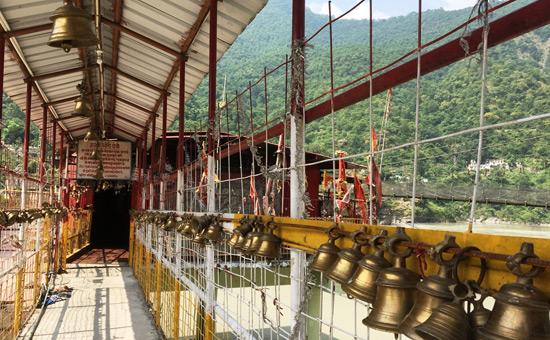 Bridge to temple. 2 people can barely pass each other on it.
Bridge to temple. 2 people can barely pass each other on it.
According to tradition
and as mentioned in the Puranas, when Sati’s body was dismembered by Vishnu, her body parts fell and the spots mark the Shakti Peeths or seat of Shakti. In Dhari Devi it’s the upper torso that is believed to be embedded and worshipped by devotees since time immemorial.
My personal understanding is that Shakti Sthals, are locations of meteors that at some point in the formation of our earth, fell and became dynamos radiating power. This understanding is of course open to debates, disbelief and ridicule, but I’m sharing this anyway.
Can we be sensitive
to nature and the environment?
Whether human
interventions interfere in the power disbursement of such spots creating
calamities is a matter of speculation. Subjective experiences are not proof and
cannot be explained in the objective world. And in this instance insensitivity
to local customs, age-old belief system was trampled upon in the race to build
the mega project.
It doesn’t take much to listen to grievances of our simple folks in the villages. They have a wisdom backed by experience far beyond the scope of those driven by business acumen.
There is no disputing the fact that India’s needs development. But the way we go about it, the impact on environment and delicate eco-systems and the manner in which we treat the very people for whom this is being done and what really drives the motive of the government is the crux here.
Shifting a Shakti Sthal for some MW of power. Was it worth it? You decide.
Author is a Kriyacharya.
Also read
1. Uttarakhand
ignores divine rage
2. Kedarnath – Wrath of the Devas